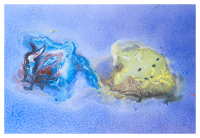Speaker
Andria Agadjanov
(University of Bonn)
Description
Lattice quantum chromodynamics (LQCD) provides an ab initio way to study the non-perturbative aspects of strong interaction. In recent years, it plays a more significant role in experimental physics.
The studies of the different electromagnetic and weak processes on the lattice are of particular interest. Some of the important processes proceed through the resonances. However, the resonances are treated as stable particles in current lattice simulations, due to the large pion mass values. The LQCD data on the corresponding transition form factors are thus obtained under this assumption. The situation changes drastically at lower values of quark masses, since the resonances decay. Consequently, a proper theoretical framework for the lattice extraction of these form factors is needed.
We rely on the previous work [1], in which the so called non-relativistic effective field theory framework for resonance matrix elements was developed. We modify and apply it to the following physically interesting processes:
- The pion photoproduction $\gamma N\rightarrow\pi N$ near the $\Delta(1232)$ resonance region. The $\Delta N\gamma$ transition is experimentally most accessible one to reveal a possible hadron deformation. We show in the recent paper [2], how to extract the $\Delta N\gamma$ transition multipoles from lattice data. We also give a prescription to calculate the $\Delta N\gamma$ form factor at the resonance pole. We argue that the second approach is less model-independent.
- The rare B-meson decays with $K(892)\rightarrow K\pi$ in the final state. These processes are forbidden at tree level and thus sensitive to physics beyond the Standard Model. However, the main obstacle here is a lack of good theoretical control over the hadronic uncertanities. LQCD can potentially provide such a control. The work is in progress and proceeds along the lines of ref. [2].
Author
Andria Agadjanov
(University of Bonn)
